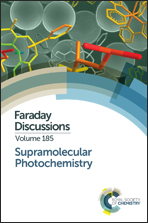Ultrafast charge transfer dynamics in supramolecular Pt(ii) donor–bridge–acceptor assemblies: the effect of vibronic coupling†
Abstract
Thanks to major advances in laser technologies, recent investigations of the ultrafast coupling of nuclear and electronic degrees of freedom (vibronic coupling) have revealed that such coupling plays a crucial role in a wide range of photoinduced reactions in condensed phase supramolecular systems. This paper investigates several new donor–bridge–acceptor charge-transfer molecular assemblies built on a trans-Pt(II) acetylide core. We also investigate how targeted vibrational excitation with low-energy IR light post electronic excitation can perturb vibronic coupling and affect the efficiency of electron transfer (ET) in solution phase. We compare and contrast properties of a range of donor–bridge–acceptor Pt(II) trans-acetylide assemblies, where IR excitation of bridge vibrations during UV-initiated charge separation in some cases alters the yields of light-induced product states. We show that branching to multiple product states from a transition state with appropriate energetics is the most rigid condition for the type of vibronic control we demonstrate in our study.
- This article is part of the themed collections: Supramolecular Photochemistry and Celebrating the 2017 RSC Prize and Award Winners

 Please wait while we load your content...
Please wait while we load your content...